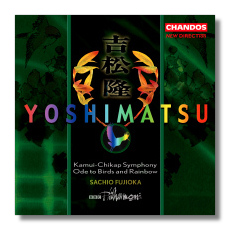
The Internet's Premier Classical Music Source
Related Links
- Latest Reviews
- More Reviews
-
By Composer
-
Collections
DVD & Blu-ray
Books
Concert Reviews
Articles/Interviews
Software
Audio
Search Amazon
Recommended Links
Site News
 CD Review
CD Review
Takashi Yoshimatsu

Orchestral Music
- Kamui-Chikap Symphony (Symphony #1)
- Ode to Birds and Rainbow
BBC Philharmonic Orchestra/Sachio Fujioka
Chandos CHAN9838 62:45
Kamui-Chikap, in Ainu mythology, is the "God Bird" who watches the people of the Earth from the branches of the tallest trees. Takashi Yoshimatsu named his first symphony for this mythical creature partly to recognize the compositional fragments and false starts that preceded it. The result is an eclectic symphony that draws from many facets of the composer's background, from ancient Japanese music to rock and minimalism, yet within a "Western" symphonic tradition. What exactly makes this a "symphony," apart from its name, is difficult to determine, yet the music is colorful and exotic enough to disarm criticisms about form.
The 45-minute work is in five sections corresponding to "Ground," "Water," "Fire," "Air," and "Rainbow" (the five "elements" in Buddhism) and to the cosmic states of Creation, Conservation, Destruction, Enchantment, and Release. Against the pregnant rumbling of low strings, "Ground" collects fleeting impressions from the forest to form a more substantial and organized mass of sound. "Water" is jewel-like and mostly still, although rippled or disturbed from time to time by light breezes, or possibly by the movement of creatures on its surface and below. Primitive "Fire," which quickly burns itself out, sounds like a summit between Leonard Bernstein, Christopher Rouse, and Emerson, Lake, and Palmer. "Air" is refreshingly cool and static, with strings that waft upwards like smoke and delicate chiming from the percussion section. The movement continues with a series of tender solos for violin, shakuhachi-style flute, and other instruments, and with the ebbing and flowing of divided strings. Piano, celesta, and bells magically paint "Rainbow," slightly faster and more densely textured, with the Messiaenic evocation of birdsong. The symphony ends in peace and gentle light.
Ode to Birds and Rainbow, which frequently reminded me of Steve Reich, was written in memory of Yoshimatsu's sister, who died at a young age, but in peace, and with the recorded songs of birds in her ears. The composer writes that "it is not a requiem, but an ode to a soul at play amidst birds and rainbow in the sky." A quiet introduction sets a tender and impressionistic mood, and then a section marked "Tapestry I" weaves a strong melody among minimalist figures that sound like the happy calls of birds in flight. The piano echoes a sacred song in the central (and rather Góreckian)
"Canticle," and then "Tapestry II" returns to and intensifies the style and life-giving mood of "Tapestry I."
Yoshimatsu has been recorded extensively by Chandos, who, unless I am mistaken, signed him on as "house composer" a few years back. His Second (CHAN9438) and Third (CHAN9737) Symphonies are available from Chandos with the same performers; his Piano Concerto also has been recorded (CHAN9652). The performances seem fine – Ode to Birds and Rainbow is a première recording – and the engineering lets no one down.
Copyright © 2001, Raymond Tuttle


















